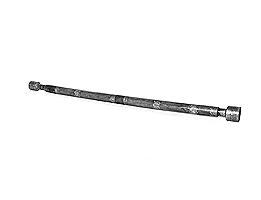 Fig. 107
Fig. 107
Modern replica
 Fig. 107
Fig. 107
The exhibition ends not with an instrument from the repertoire of practical mathematics but with a telescope. The invention of the telescope inaugurated a novel class of scientific instruments. These new optical instruments, which soon included the microscope as well as the telescope, were distinct from the traditional instruments of practical mathematics through their use of lenses and mirrors. They also quickly came to be manufactured by a distinct group of optical instrument makers. Despite such differences, optical instruments such as the telescope were, like mathematical instruments, intimately bound up with military preoccupations.
The first public announcement of the telescope was a printed newsletter describing the visit of an embassy of the King of Siam to Prince Maurice of the Netherlands in October 1608 - an unlikely setting for an instrument that is now one of the classic icons of science. But it was as a military instrument that the new invention was initially perceived and the newsletter was quite explicit about the purpose of the device. 'The said glasses are very useful in sieges and similar occasions, for from a mile and more away one can detect all things as distinctly as if they were very close to us.'
The publication of the newsletter destroyed efforts to keep the existence and construction of the telescope a secret and reports of the marvellous novelty were transmitted with incredulity and excitement. Within a few months copies of the telescope were being sold in several European cities.
On hearing news of the invention, Galileo set about constructing and improving his own version. After presenting his telescope to the Venetian Senate, Galileo was honoured with a promise that his salary be doubled and his appointment at the University of Padua confirmed for life. These rich rewards were offered before he had made his astronomical discoveries; Venice was recognising the strategic rather than scientific importance of Galileo's improvements.
Galileo already well knew the value of instruments within the realm of patronage. His sector or 'geometric and military compass' was a prime example. Devised for military uses in 1597 and afterwards revised, examples were offered to both the Medici and the Gonzaga courts. It also formed the basis of private courses taught by Galileo in Padua in the first years of the 17th century, though his military teaching included fortification as well. The sector was an important device for practical mathematics and several military versions appear elsewhere in the exhibition. But it could not match the telescope for spectacle and the wide-ranging implications of the observations made with its help.
Perhaps prophetically, the original 1608 report mentioned that, in addition to its evident military worth, the new device could also be turned on the heavens. Months before Galileo had even heard of the invention it was already being reported that 'even the stars which ordinarily are invisible to our sight and our eyes, because of their smallness and the weakness of our sight, can be seen by means of this instrument.' The results of observing the celestial appearances not only propelled Galileo into a new position as Mathematician and Philosopher at the Medici court but redirected contemporary debate in astronomy and natural philosophy. From a military device whose dissemination states sought to control, the telescope became a more subtly destructive instrument, used to provide vital new evidence for the Copernican cosmology. For a figure such as Galileo, it was only a short step from the geometry of war to the new science of the 17th century.
This instrument is a copy of one of Galileo's telescopes preserved in Florence. The drawtubes are of wood covered with decorated vellum and leather and the magnification is about x20.
Length (closed): 923 mm
Inventory no. 37,599